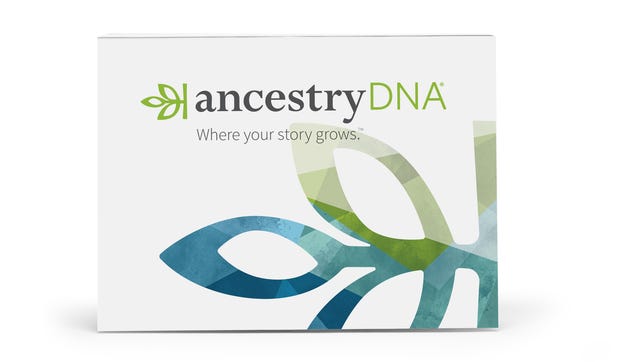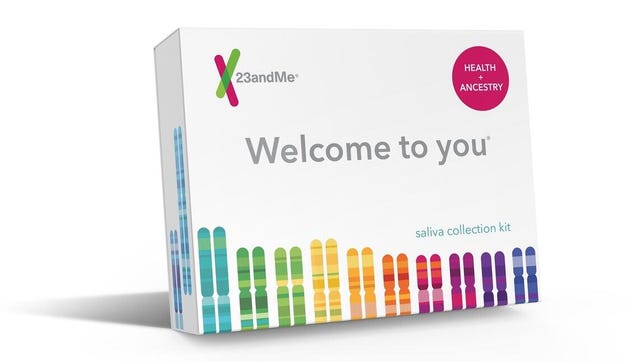In this article:
AncestryDNA (a subsidiary of Ancestry.com) and 23andMe are two popular DNA testing kits that help you learn about your family history. Both require a saliva sample to analyze your DNA and infer where your ancestors originated from. The analysis can also potentially detect relationships with other users based on their submitted samples. In addition, the analyses can also provide wellness and health reports with information on cancer risks, health predispositions, carrier status and more.
We tried both DNA testing kits. Here’s how to tell which one is best for you.
Ancestry vs. 23andMe
AncestryDNA
I tried the AncestryDNA kit, which comes with a saliva collection tube and cap, a return bag and a prepaid return label box. To register the kit, I downloaded the Ancestry app and scanned the barcode on the side of the collection tube. You can register your kit online too, and just manually enter the number.
When you make an account, the app asks for your consent on several items, including consent to process your sample, to store the sample if you want future testing, and to participate in research. Research includes taking surveys and questionnaires that AncestryDNA says it will use to attempt to better understand human history and health.
I declined consent to store my sample or participate in research. AncestryDNA asks a few questions about your health history. You can edit what information becomes public or private on the site, and how you want to appear to other users if your DNA matches with someone else. You’ll have an opportunity to review all information before proceeding.
Read more: In the Future, Not Even Your DNA Will Be Sacred
Ancestry has 16 million user profiles, compared to 23andMe’s 10 million, which should in theory mean more accurate results. However, Ancestry does not use the standard Y-chromosome and/or mitochondrial DNA methodologies most others use — so we know less about how it actually analyzes DNA.
After spitting in the tube, I mailed off the kit and confirmed that it was sent off in the app. The app “tracked” the kit’s journey from being received at the lab to processing and more before it told me my results were in.
Your results will include an AncestryHealth report and an Ethnicity Estimate report. AncestryDNA also tells you which other users your DNA closely matches with. It flagged my aunt, who also used the site, as Close Family. The app let me compare our Ethnicity Estimates and gave me the option to send her a message.
Read more: What AncestryDNA Taught Me About DNA, Privacy and the Complex World of Genetic Testing
AncestryDNA’s best features:
- You can decline to have your sample stored or participate in research.
- The AncestryHealth report came in first, and was broken down into Notable Health Results, Health Results and Wellness Results. The reports include information about cancer risks, carrier status for diseases like cystic fibrosis and your blood health.
- The wellness reports break down to give you information on your vitamin levels, among other things.
- AncestryHealth can flag potential health conditions based on the family history you filled out, or by variants detected in your DNA sample.
- You get an Ethnicity Estimate report, which shows which regions in the world your ancestors were most likely linked to. This area on the map was color-coded, along with the others that my DNA was linked to. The AncestryDNA Regions list has over 1,000 regions that your sample is tested against, so you’ll see where your DNA didn’t turn up results, too. The report also includes a brief history of each area.
Things to consider:
- A downside was that the family tree aspect and the DNA aspect required two separate apps; however, the desktop version keeps it all in one place if you work on a browser.
- The site reiterates multiple times that the report you receive isn’t a diagnosis. The health screening also does not have Food and Drug Administration approval.
23andMe
I tried the Health and Ancestry kit which came with the saliva collection tube and cap, a return bag and a prepaid return label box. Like AncestryDNA, 23andMe also required kit registration (in-app or online) prior to testing. I downloaded the app and scanned the barcode on the side of the collection tube. You can also manually enter the code.
The 23andMe kit asked for consent on several items when I made an account, as AncestryDNA did. I could store my sample for future tests, participate in research, get health reports and had the ability to share my steps data from a fitness app for a more comprehensive look at my activity. I declined all except the health reports.
Unlike Ancestry, 23andMe does have FDA approval as a risk screener for a handful of genetic conditions and diseases — if you’re primarily interested in DNA testing for this purpose, 23andMe is the better choice.
The app tracked my sample’s journey to the lab and the DNA extraction process. The app tested 216 populations to generate the report.
23andMe can display the results in a timeline, so you can see approximately how many generations ago your most recent ancestor came from each region. For example, my results turned up a tiny bit of Ashkenazi Jewish background, but my timeline indicated that the relative would’ve been alive five to eight generations ago. You can also view your results as a Chromosome Painting, which shows where in your chromosomes a specific region matched and how prevalent it is.
There were a lot of facets to explore in the results. For example, 23andMe gave me more information on each region my DNA matched with. If I tapped on the icon for each country, 23andMe told me about the history of the region and the people’s migration patterns over time, and also provided resources to learn about the culture, ways to book an Airbnb to visit and other features. I could also seek out possible relatives among 23andMe users, and found my mother’s cousin.
23andMe’s best features:
- 23andMe is FDA approved as a risk screening.
- 23andMe’s health reports included predispositions, carrier status, wellness, traits and a health action plan. Predispositions tested for Parkinson’s disease, Type 2 diabetes, celiac disease and more. The lab would test for certain genetic variants.
- The wellness report included interesting items like whether or not you’re a deep sleeper, how much you likely move in your sleep, genetic weight and other factors.
- The traits reported are particularly interesting. These detailed how likely I was to be able to have a certain eye color, hate cilantro, have freckles, hate eating sounds, get bitten more by mosquitos and other things.
Things to consider:
- Like with AncestryDNA, 23andMe specified that the test results weren’t a diagnosis or a guarantee that you wouldn’t be diagnosed with a disease later on.
You’re receiving price alerts for 23andMe
AncestryDNA vs. 23andMe cost comparison
The best DNA kits will have different services that come at varying prices. Let’s break down AncestryDNA’s and 23andMe’s services and costs.
AncestryDNA cost
- AncestryDNA ($99): Ancestry’s basic offering allows you to search its US database for family connections.
- AncestryDNA + Family Tree ($100): Includes access to international records to trace your family lineage.
- AncestryDNA Traits + All Access ($199): In addition to the other services, you can access historical records and 35 genetic traits with this tier.
23andMe cost
23andMe offers three different DNA testing kits. All three products include ancestry reports, relative-finding options, trait reports and family tree building.
- Ancestry and Traits Service ($99): Includes ancestry reports, relative finding options, trait reports and family tree building.
- Health and Ancestry Service ($199): Includes carrier status reports, health predispositions and wellness reports.
- 23andMe Plus Membership ($169 upfront and $29 annually): Only the 23andMe Plus membership enhanced ancestry features, pharmacogenetics reports and consistent updates to existing reports.
You can order further health reports through the base service for an extra $125.
The bottom line
Ancestry is best known for its family tree feature. When you use its DNA testing service and integrate those results, you can view everything in one browser. The information is split across two different mobile apps, however, which is less helpful. But overall, Ancestry’s tools, including the ability to build a tree and link your health and DNA insights, definitely help paint a bigger picture of a person’s origins and can help facilitate a conversation with newly discovered family members.
23andMe has a more user-friendly layout, and presents its findings in a way that encourages you to immerse yourself in your (possibly newfound) heritage. However, it lacks the strength that Ancestry has when it comes to building your family tree. I could view a predicted tree, but it was sparse and only included other 23andMe users.
Because I was already familiar with my family’s origins, I can say that both kits seemed to yield accurate results.
You should choose AncestryDNA if:
- You’re just looking to learn about your own genetics and traits in an easy-to-read format, or are looking primarily for health information, I’d go with 23andMe.
You should choose 23 and me if:
- You’re working on a family history project and are already familiar with the Ancestry platform, I’d go with it instead.
For more, find out how I used tech to uncover more about my own family tree
. You can also order a DNA test from other services for your pet, if you really want to.
Ancestry vs. 23andMe FAQs
Which is more accurate, AncestryDNA or 23andMe?
Both AncestryDNA and 23andMe seemed to yield accurate results. Ancestry has a bigger DNA database, but 23andMe has a more user-friendly layout. They are two of the best options you can get.
What is the difference between 23andMe and Ancestry?
23andMe and Ancestry are two of the best DNA kits you can use. When deciding which one you want to choose, it comes down to what you’re looking to get out of your search. If you’re looking for thorough health information, go with 23andMe. Ancestry is the better option if you’re looking to track down family or chart your lineage.
The information contained in this article is for educational and informational purposes only and is not intended as health or medical advice. Always consult a physician or other qualified health provider regarding any questions you may have about a medical condition or health objectives.




